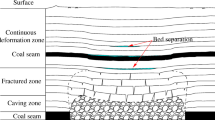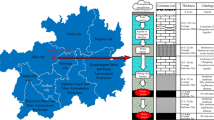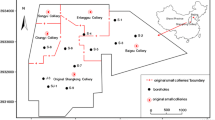Abstract
The Wangjialing Mine in southern Shanxi Province is seriously threatened by roof water and is infamous for a water inrush disaster that happened there in 2010. A root-cause-analysis was conducted. Three key issues, the height of the mining-induced fractured zone in formations overlying the coal seam, the water yield of aquifers overlying the coal seam, and working face water inflows before and after pretreatment of roof water-bearing aquifers, were studied based on the “three maps–two predictions” approach. According to the multi-source information composite principle, abundance zoning maps of the roof aquifer were made using the overlapping function of geographic information system (GIS) for five controlling factors: aquifer thickness, total core recovery, drilling fluid quantity, permeability, and thickness of brittle and plastic strata. Borehole-specific data from in-situ pumping tests were used to verify the water abundance results. For areas that did not meet the verification requirements, the weights of the controlling factors were calibrated by reestablishing the analytic hierarchy process judgment matrix. The total height of the fractured zone within the #2 coal seam roof was calculated using an empirical formula. An established roof crack safety zoning map was used to evaluate that aspect. A three-dimensional numerical simulation of the groundwater flow system was established based on the site conceptual model of the roof aquifer and was used to predict the working face inflows. The results indicated that the 20,518 working face of the 205 panel had the greatest abundance of water.
抽象
王家岭煤矿位于山西省南部,受顶板水害威胁严重;2010年曾发生严重的“3.28”突水事故。基于“三图-双预测法”研究了煤层顶板导水裂隙带高度、充水含水层富水性和含水层处理前后工作面涌水量。运用GIS对影响含水层富水性的含水层厚度、岩心采取率、钻孔冲洗液消耗量、渗透系数及顶板脆/塑岩层比等5个因素进行多源信息叠加,绘制充水含水层富水性分区图。利用现场试验所得钻孔单位涌水量验证富水性评价结果,运用层次分析判断矩阵法修正不吻合区的多因素权重。运用经验统计公式计算2#煤层顶板导水裂缝带高度,建立了煤层顶板冒裂安全性分区图。两个分区图叠加生成突水危险性评价图。根据王家岭矿2#煤层顶板充水水文地质概念模型,建立地下水流系统三维数值模拟模型以预测工作面涌水量。结果表明205盘区20518工作面富水性最强。
Zusammenfassung
Die Wangjialing Mine in der südchinesichen Provinz Shanxi ist durch hangendes Grundwasser gefährdet. Im Jahr 2010 ereignete sich dort ein katastrophaler Wassereinbruch. Eine Ursachenanalyse wurde durch-geführt. Dazu wurden drei Schwerpunktthemen untersucht: die Höhe der bergbauinduzierten Bruchzone im Hangenden des Kohleflözes; die Ergiebigkeit der Grundwasserleiter im Hangenden des Kohleflözes sowie der Zustrombereich vor und nach der Vorbehandlung der wasserführenden Grundwasserleiter. Dafür wurde das sogenannte 3-Karten-2-Vorhersagen-Konzept genutzt. Mittels geographischem Informationssystem (GIS) wurden thematische Karten der hangenden Grundwasserleiter erstellt. Diese enthielten fünf wesentliche Informationen: Grundwasserleiter¬mächtigkeit, Kerngewinn, Menge der Bohrspülung sowie Durchlässigkeit und Mächtigkeit der brüchigen und der plastischen Schichten. Bohrloch¬spezifische Ergebnisse aus Pumpversuchen wurden genutzt, um das Wasserdargebot zu ermitteln. Die Gesamthöhe der Bruchzone im Hangenden des 2. Kohleflözes wurde mit Hilfe einer empirischen Gleichung berechnet. Zur Bewertung wurde eine Karte der Sicherheitszone für den Firsteneinsturz verwendet. Der Zustrombereich des Grundwassers aus dem Hangenden wurde mit einem dreidimensionalen numerischen Grund¬wasserströmungsmodell prognostiziert. Die Ergebnisse zeigen, dass der Abbaustoß 20518 im Abbaufeld 205 die größte Wasserhöffigkeit aufweist.
Resumen
La mina Wangjialing en el sur de la provincia Shanxi está seriamente amenazada por el agua del techo y es conocida por un desastre provocado por irrupción de agua que ocurrió en 2010. Se realizó un análisis de causa-raíz. Basados en la aproximación “tres mapas-2 predicciones“ se estudiaron tres problemas centrales: la altura de la zona de fractura inducida por las tareas mineras en las formaciones que rodean la veta de carbón, el contenido de agua de los acuíferos que rodean la veta de carbón y los afluentes de agua hacia la cara de trabajo antes y después del pretratamiento de los techos conteniendo acuíferos. De acuerdo al principio de información multifuente, las mapas de zonas del acuífero del techo fueron hechos usando una función superpuesta del sistema de información geográfica (GIS) para cinco factores de control: espesor del acuífero, recuperación del núcleo total, cantidad del fluido de perforación, permeabilidad y grosor de los estratos frágiles y plásticos. Para verificar los resultados de abundancia de agua se utilizaron datos específicos de pozos de las pruebas de bombeo in situ. En las áreas donde no se verificaron los requerimientos, los pesos de los factores fueron calibrados por restablecimiento de la matriz de comparación del proceso jerárquico analítico. El peso total de la zona fractura dentro del techo de la veta de carbón #2 fue calculado a través de una fórmula empírica. Para evaluar este aspecto se utilizó un mapa de zonificación de la seguridad de la grieta del techo. Se estableció una simulación numérica tridimensional del sistema de flujo del agua subterránea basado sobre el modelo del acuífero del techo y fue usado para predecir los entradas a través de las caras de trabajo. Los resultados indicaron que la cara 20518 del panel 205 tenía la mayor abundancia de agua.










Similar content being viewed by others
References
Booth CJ (1986) Strata-movement concepts and the hydrogeological impact of underground coal mining. Ground Water 24:507–515
Booth CJ, Bertsch L (1999) Groundwater geochemistry in shallow aquifers above longwall mines in Illinois, USA. Hydrogeol J 7:561–575
Booth CJ, Curtiss AM, Demaris PJ, Bauer RA (2000) Site-specific variation in the potentiometric response to subsidence above active longwall mining. Environ Eng Geosci 6:383–394
Dong S (2007). Current situation and prospect of coal mine geological guarantee technologies to improve safety and efficiency. Coal Sci Tech 35(3):1–5 (in Chinese)
Hill JG, Price DR (1983) The impact of deep mining on an overlying aquifer in western Pennsylvania. Ground Water Monit Rev 3:138–143
Hu W, Wang G (1997) Development of technique of controlling water hazard on coal mine. Coal Geol Explor 25:17–23 (in Chinese)
Islam MR, Hayashi D, Kamruzzaman AB (2009) Finite element modeling of stress distributions and problems for multi-slice longwall mining in Bangladesh, with special reference to the Barapukuria coal mine. Int J Coal Geol 78:91–109
Kim JM, Parizek RR, Elsworth D (1997) Evaluation of fully-coupled strata deformation and groundwater flow in response to longwall mining. Int J Rock Mech Min Sci 34:1187–1199
Liu Z, Yang B (2006) The use of numerical simulation methods to determine the water flowing fractured zone development of a high degree. Min Saf Environ Prot 33(5):16–19
Liu T, Shi L, Han J (2006) Hydraulic conductivity fracture zone height calculation. J China Coal Soc 31:93–96 (in Chinese)
Qian M, Miao X, Xu J (1996) Theoretical study of key stratum in ground control. J China Coal Soc 3:225–230 (in Chinese)
Rauch HW (1989) A summary of the ground water impacts from underground mine subsidence in the north central Appalachians. Ch 2. Coal Mine Subsidence Special Institute, Eastern Mineral Law Foundation, Pittsburgh, pp 201–231
Singh MM, Kendorski FS (1981) Strata disturbance prediction for mining beneath surface water and waste impoundments. In: Proc. 1st Conf on Ground Control in Mining, Morgantown, pp 76–88
State Council of the PRC (2014) Energy development strategy action plan (2014–2020). http://www.gov.cn/zhengce/content/2014-11/19/content_9222.htm. Accessed 7 June 2014
State Council of the PRC (2016) The opinions of about the coal industry solve the excess capacity to realize the difficulty relief development. http://www.gov.cn/zhengce/content/2016-02/05/content_5039686.htm. Accessed 1 Feb 2016
Wu Q (1995) The mine water management decision system of North China coal fields. China Coal Industry Publ House, Beijing (in Chinese)
Wu Q (2002) Prevention and treatment of mine water hazardous disaster. China University of Mining and Technology Press, Xuzhou (in Chinese)
Wu Q (2014) Progress, problems and prospects of prevention and control technology of mine water and reutilization in China. J China Coal Soc 39(5):795–805 (in Chinese)
Wu Q, Wang M (2006) Characterization of water bursting and discharge into underground mines with multi-layered ground-water flow systems in the North China Coal Basin. Hydrogeol J 14(6):882–893
Wu Q, Zhou W (2008) Prediction of inflow from overlying aquifers into coalmines: a case study in Jinggezhuang coal mine, Kailuan, China. Environ Geol 55:775–780
Wu Q, Zhao S, Sun W Liu S, Zeng Y (2013) Classification of the hydrogeological type of coal mine and analysis of its characteristics in China. J China Coal Soc 38(6):901–905 (in Chinese)
Wu Q, Liu Y, Zhou W, Li B, Zhao B, Liu S, Sun W, Zeng Y (2015a) Evaluation of water inrush vulnerability from aquifers overlying coal seams in the Menkeqing Coal Mine, China. Mine Water Environ 34(3):258–269
Wu Q, Liu Y, Luo L, Liu S, Sun W, Zeng Y (2015b) Quantitative evaluation and prediction of water inrush vulnerability from aquifers overlying coal seams in Donghuantuo Coal Mine, China. Environ Earth Sci 74(2):1429–1437
Xu J, Qian M (2000) Distinguishing method of position of overlying key stratum. J China Univ Min Technol 29(5):463–467 (in Chinese)
Xu Y, Li J, Liu S, Zhou L (2011) Computational formula of “two-zone” height of overlying strata and its adaptability analysis. Coal Min Technol 16(2):4–11 (in Chinese)
Xu D, Peng S, Xiang S, Liang M, Liu W (2016) The effects of caving of a coal mine’s immediate roof on floor strata failure and water inrush. Mine Water Environ 35(3):337–349
Zeng Y, Liu S, Zhang W, Zhai Y. (2016a) Application of artificial neural network technology to predicting small faults and folds in coal seams, China. Sustain Water Resour Manag 2(2):175–181
Zeng Y, Wu Q, Liu S, Zhai Y, Zhang W, Liu Y (2016b) Vulnerability assessment of water bursting from Ordovician limestone into coal mines of China. Environ Earth Sci 75:1431. doi:10.1007/s12665-016-6239-4
Acknowledgements
This research was financially supported by the: China National Scientific and Technical Support Program (2016YFC0801801), China National Natural Science Foundation (41572222, 41430318, 41602262), Fundamental Research Funds for the Central Universities (2010YD02), China Postdoctoral Science Foundation (2016M601172), and the Open Fund of the Hebei State Key Laboratory of Mine Disaster Prevention (KJZH2016K01). The authors also thank the editors and reviewers for their constructive suggestions.
Author information
Authors and Affiliations
Corresponding author
Electronic supplementary material
Below is the link to the electronic supplementary material.
10230_2017_459_MOESM2_ESM.pdf
Supplementary Fig. 2a–e: Thematic map of water yield property evaluation (a) The thematic map of the thickness of Permian sandstone aquifer, (b) The thematic map of the recovery ratio of core, (c) The thematic map of the drilling fluid quantity, (d) The thematic map of the thickness ratio of brittle rock and plastic rock, (e) The thematic map of the permeability coefficient (PDF 1611 KB)
Rights and permissions
About this article
Cite this article
Zeng, Y., Wu, Q., Liu, S. et al. Evaluation of a coal seam roof water inrush: case study in the Wangjialing coal mine, China. Mine Water Environ 37, 174–184 (2018). https://doi.org/10.1007/s10230-017-0459-z
Received:
Accepted:
Published:
Issue Date:
DOI: https://doi.org/10.1007/s10230-017-0459-z




